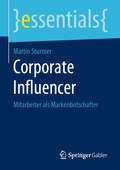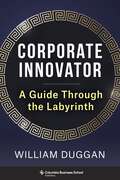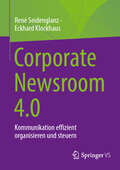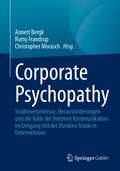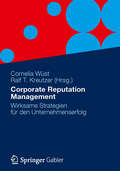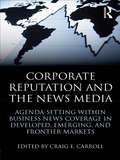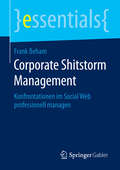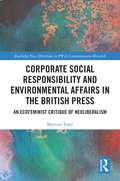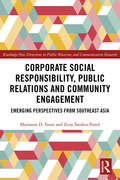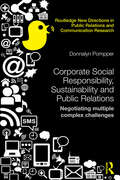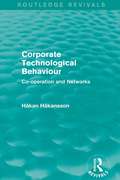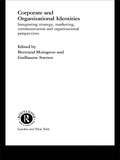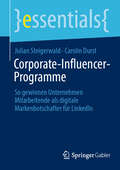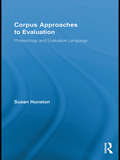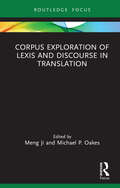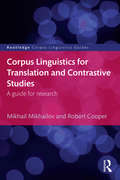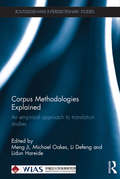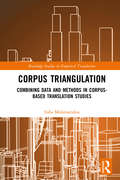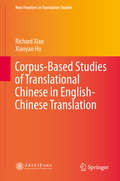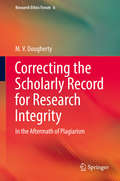- Table View
- List View
Corporate Influencer: Mitarbeiter als Markenbotschafter (essentials)
by Martin SturmerMartin Sturmer zeigt in diesem essential, dass Mitarbeiter die besten Markenbotschafter sind – im Unterschied zu externen Influencern überzeugen Kommunikatoren aus dem eigenen Unternehmen (Corporate Influencer) durch Authentizität, Engagement und Fachwissen. Corporate Influencer haben ein enormes Potenzial: Sie stärken die Markenbekanntheit und steigern die Interaktionsraten mit Kunden und Interessenten. Außerdem verbessern sie die Mitarbeiterbindung und unterstützen den Aufbau einer starken Arbeitgebermarke. Der Autor vermittelt die wichtigsten Methoden und Instrumente für Unternehmen, die selbst ein erfolgreiches Corporate-Influencer-Programm ins Leben rufen wollen.
Corporate Innovator: A Guide Through the Labyrinth
by William DugganInnovation is a top priority for all kinds of organizations, of all sizes and shapes, throughout the world. But innovation doesn’t happen only at the executive level. People within an organization come up with great ideas that can propel the company forward. All too often, however, would-be innovators find that the organization is unreceptive to their new ideas. They are stymied by bureaucracy, power dynamics, or countless other barriers to innovation. They find themselves lost in a labyrinth that blocks them everywhere they turn.William Duggan—a leading expert on innovation and strategic thinking—offers a guide to navigating the maze from idea to implementation. He provides practical advice on communicating new ideas effectively, getting buy-in from others, winning allies, and overcoming resistance or outright opposition to innovation. Duggan focuses on the strategy and tactics of building support within the organization, exploring the crucial takeaways from research in psychology about how people react to new ideas. This book includes a series of interviews with successful corporate innovators as well as analysis of historical cases that combine lively storytelling with actionable insights. For anyone in an organization who has been frustrated with the lack of innovation, Corporate Innovator delivers an essential roadmap for going from idea to action.
Corporate Newsroom 4.0: Kommunikation effizient organisieren und steuern
by René Seidenglanz Eckhard Klockhaus(Corporate) Newsrooms stellen im Kommunikationsmanagement ein Phänomen dar, welches sich immer weiter verbreitet und zunehmend in der Praxis durchsetzt. Demgegenüber steht eine – auch in unserer Forschung ermittelte – große Unsicherheit über Planung, Organisation und Umsetzung solcher Newsrooms.Vor diesem Hintergrund wird der Band gleichwohl relevante theoretische und wissenschaftliche Aspekte und Vorgehensmodelle einbeziehen, etwa aus der Betriebswirtschafts- resp. Managementlehre. Gleichermaßen bleibt sie dem kommunikationswissenschaftlichen Diskurs verbunden und beschreibt wirtschaftliche und organisatorische Faktoren. Es wird ganz konkret Nutzenmodelle vorstellen sowie Handlungsempfehlungen und Vorgehensweisen vorschlagen. Dieses Buch geht damit über den Status Quo der Marktbeobachtungen hinaus und bildet die Brücke zwischen Anforderungen und Machbarkeiten ab. Es leistet eine ganzheitliche Betrachtung von (Corporate) Newsrooms durch Einbettung in wissenschaftlicheDebatten und feldspezifische Herausforderungen und ermöglicht praktische Reflexion und konkrete Umsetzung von (Corporate) Newsrooms.
Corporate Psychopathy: Studienergebnisse, Herausforderungen und die Rolle der Internen Kommunikation im Umgang mit der Dunklen Triade in Unternehmen
by Annett Bergk Romy Frandrup Christopher MoraschIn diesem Buch gehen Kommunikationsexpert*innen aus Theorie und Praxis der Frage nach, wie „psychopathisch“ es in den heutigen Führungsebenen zugeht. Seit mehr als 20 Jahren ist der Begriff der „Dunklen Triade“ aus psychologischer und medizinischer Forschung bekannt und begegnet uns seitdem regelmäßig in den Medien, die über die Verbreitung dieses Dreiklangs aus Narzissmus, Machiavellismus und Psychopathie in den Führungsetagen und Vorstandszimmern der Welt berichten. Dieses Fachbuch richtet sich an Menschen, die in Teams arbeiten, selbst als Führungskräfte im Einsatz sind oder sich mit der Optimierung von Teamwork beschäftigen. Es soll aufzeigen, wie Personen mit psychopathischen, machiavellistischen oder narzisstischen Tendenzen in Unternehmen agieren, welche Effekte sie auf das Team haben und wie verschiedene Situationen kommunikativ verbessert werden können.. Es wird ein Forschungsüberblick zu narzisstischen, machiavellistischen und psychopathischen Führungskräften in der Arbeitswelt gegeben und vorgestellt, wie Corporate Psychopaths in den Medien dargestellt werden. Ein Beitrag geht der Frage nach, warum Führungskräfte manchmal vielleicht auch narzisstisch wirken müssen. In einem umfangreichen Beitrag werden die Unterschiede psychopathischer Persönlichkeitszüge zwischen Manager*innen und Menschen ohne Führungsverantwortung analysiert und dargelegt, was es bei der Besetzung von Managementpositionen zu berücksichtigen gilt. Mehrere Beiträge beschäftigten sich mit der besonderen Rolle der Internen Kommunikation: Wie kann die Interne Kommunikation schwierige Unternehmenspersönlichkeiten erkennen und welches Wissen braucht sie für einen erfolgreichen Umfang mit diesen? Es wird gezeigt, wie es gelingen kann, die negativen Effekte von Corporate Psychopathy einzudämmen und die Chancen der Personalauswahl bei der Identifikation von Corporate Psychopaths werden eingeordnet.
Corporate Public Affairs: Interacting with Interest Groups, Media, and Government
by Otto LerbingerCorporate Public Affairs explores the increasing interest in public affairs by today's organizations. Lerbinger indicates that more and more frequently corporations are establishing public affairs positions--typically within public relations departments--to respond to issues and concerns arising out of the sociopolitical environment in which the corporation functions. He articulates the functions and responsibilities of the public affairs role, and investigates the approaches to dealing with primary constituencies--interest groups, media, and government.Divided into five parts, this book:*provides an overview of the corporate public affairs function;*explores strategies of the myriad interest groups in the United States, such as labor unions and environmental, consumer, women's, and human rights groups;*recognizes the media's increasing coverage of business events, especially negative ones, that have tremendous power both to undermine corporate credibility and to support public policy positions;* deals with legislative, executive, and judicial branches of government; and*raises the question of how corporate power strategies have affected the political marketplace.This book will appeal to advanced-level students, scholars, and practitioners in public relations and business fields.
Corporate Public Relations: A New Historical Perspective (Routledge Communication Series)
by Marvin N. OlaskyThis volume presents a historical and objective overview of the field of public relations in the past century. It discusses some of the landmark cases in public relations, critiques the philosophies of innovators such as Ivy Lee and Edward Bernays, and explores how corporate public relations has affected economic and political trends. The author concludes by offering long-term alternatives for the future of public relations valuable to both practitioners and corporate executives.
Corporate Reputation Management: Wirksame Strategien für den Unternehmenserfolg (Essentials)
by Ralf T. Kreutzer Cornelia WüstDer gute Ruf' eines Unternehmens ist nicht auf das Ergebnis von Image-Kampagnen zu beschränken, sondern bindet auch alle Marken sowie das Unternehmen als Ganzes mit seinen internen und externen Stakeholdern ein. Ausgewiesene Spezialisten diskutieren konkrete Frage- und Infrage-Stellungen zu bestehenden Konzepten und zeigen auf, durch welche Ansätze mit welchen Verantwortlichkeiten (bspw. von Unternehmenskommunikation und Medien) und Strategien nachhaltige Erfolge zu erzielen sind. Namhafte Vertreter aus Industrie, Beratung und Forschung präsentieren Lösungskonzepte.
Corporate Reputation and the News Media: Agenda-setting within Business News Coverage in Developed, Emerging, and Frontier Markets (Routledge Communication Series)
by Craig E. CarrollThis volume examines agenda-setting theory as it applies to the news media’s influence on corporate reputation. It presents interdisciplinary, international, and empirical investigations examining the relationship between corporate reputation and the news media throughout the world. Providing coverage of more than twenty-five countries, contributors write about their local media and business communities, representing developed, emerging, and frontier markets – including Argentina, Brazil, Chile, China, Germany, Greece, Japan, Nigeria, Spain, and Turkey, among others. The chapters present primary and secondary research on various geo-political issues, the nature of the news media, the practice of public relations, and the role of public relations agencies in each of the various countries. Each chapter is structured to consider two to three hypotheses in the country under discussion, including: the impact of media visibility on organizational prominence, top-of-mind awareness and brand-name recognition the impact of media favorability on the public’s organizational images of these firms how media coverage of specific public issues and news topics relates to the associations people form of specific firms. Contributors contextualize their findings in light of the geopolitical environment of their home countries, the nature of their media systems, and the relationship between business and the news media within their countries’ borders. Incorporating scholarship from a broad range of disciplines, including advertising, strategic management, business, political communication, and sociology, this volume has much to offer scholars and students examining business and the news media.
Corporate Reputation as Strategic Intangible Asset: An analysis of management processes, measurement methods and impact on bank and auditors’ decisions (SIDREA Series in Accounting and Business Administration)
by Diletta VitoThis book offers a comprehensive overview of corporate reputation, aiming to enhance understanding, management processes, and measurement methods associated with this crucial concept. By integrating perspectives from various disciplines such as strategic management, organizational theory, and accounting, the book presents a holistic framework for both enhancing and safeguarding corporate reputation. The book explores essential processes such as creating, acquiring, protecting, and repairing reputational capital, employing a stock and flow model to establish a robust framework for reputation management. Furthermore, the book studies the role of corporate communication and voluntary disclosure in establishing trust and credibility with stakeholders. It provides actionable strategies for reputational risk management and crisis management, emphasizing the critical importance of swift and transparent communication in safeguarding and restoring reputational capital. By addressing stakeholder-specific dynamics and offering detailed guidelines on reputation management, the book underscores the necessity of tailored efforts to meet the unique needs and concerns of diverse stakeholder groups. Designed for scholars, practitioners, business leaders, and students in business and management disciplines, this book aims to deepen their understanding of the strategic importance of corporate reputation.
Corporate Shitstorm Management: Konfrontationen im Social Web professionell managen (essentials)
by Frank BehamDas Essential vermittelt in kompakter Form Handlungsempfehlungen für Unternehmen, die mit einem Shitstorm konfrontiert sind. Auf der Basis einer Untersuchung von sieben Shitstorms stellt Frank Beham wirksame Maßnahmen zur frühzeitigen Erkennung eines Shitstorms vor und steckt einen Handlungsrahmen zur adäquaten Reaktion ab. Darüber hinaus wird der Leser befähigt, das Gefährdungspotenzial und die Konsequenzen eines Shitstorms abzuschätzen. Dieses Buch kann jedem Unternehmen nutzen, das im Social Web präsent ist, und gibt wertvolle Hinweise, wie zukünftige Konfrontationen professionell bewältigt werden können.
Corporate Social Responsibility and Environmental Affairs in the British Press: An Ecofeminist Critique of Neoliberalism (Routledge New Directions in PR & Communication Research)
by Martina TopićAn ecofeminist criticism of neoliberalism, this book uses economic growth, CSR and the press coverage of environmental affairs as a case study. The author argues that CSR is part of a wheel of neoliberalism that continually perpetuates inequality and the exploitation of women and Nature. Using an ecofeminist sense-making analysis of media coverage of food waste, global warming, plastic, economic growth and CSR, the author shows how the press discourse in writing is always similar and serves to preserve the status quo with CSR being just a smokescreen that saved capitalism and just one cog in the wheel of neoliberalism. While available research offers perspectives from business and public relations studies, looking at how CSR is implemented and how it contributes towards the reputation of businesses, this book explores how the media enforce CSR discourse while at the same time arguing for environmental preservation. The book presents a combination of quantitative and qualitative methods to explain how and why CSR is being pushed forward by the news media, and how the media preserves the status quo by creating moral panic on environmental issues while at the same time pushing for CSR discourse and economic growth, which only contributes towards environmental degradation. The original research presented in the book looks at how the media write about economic growth, plastics, food waste, CSR and global warming. This interdisciplinary study draws on ecofeminist theory and media feminist theory to provide a novel analysis of CSR, making the case that enforcing CSR as a way to do business damages the environment and that the media enforce a neoliberal discourse of promoting both economic growth and environmentalism, which does not go together. Examining the UK media as a case study, a detailed methodological account is provided so that the study can be repeated and compared elsewhere. The book is aimed at academics and researchers in business and media studies, as well as those in women’s studies. It will also be relevant to scholars in business management and marketing.
Corporate Social Responsibility, Public Relations and Community Engagement: Emerging Perspectives from South East Asia (Routledge New Directions in PR & Communication Research)
by Zeny Sarabia-Panol Marianne D. SisonDiverse in economic development, political and mass media systems, the countries in Southeast Asia cast a unique light on the parallels between development-cum-participative communication and corporate social responsibility. In our globalized environments, knowledge of power, culture and the colonial histories that influence and shape business and governance practices are increasingly important. Focusing on six countries—Indonesia, Malaysia, the Philippines, Singapore, Thailand and Vietnam—the book discusses how public relations (PR) and corporate social responsibility (CSR) discourse are constructed, interpreted, communicated and enacted in this diverse emerging region. By connecting the disparate disciplines of participatory and development communication with PR and CSR discourse, this innovative text explores the tensions between concepts of modernity and traditional values and their role in engendering creativity, compliance or resistance. This book will be of interest to researchers, educators and advanced students in the fields of public relations, communication, corporate social responsibility, corporate communications and Southeast Asia studies.
Corporate Social Responsibility, Sustainability and Public Relations: Negotiating Multiple Complex Challenges (Routledge New Directions in PR & Communication Research)
by Donnalyn PompperWhile public relations offers numerous assets for organization-stakeholder relationship building and for ethical corporate social responsibility and sustainability communication, it also faces challenges linked to negative perceptions of the profession which can lead to accusations of "greenwashing." This innovative book critically explores the growing, complex and sometimes contradictory connections among public relations, corporate social responsibility and sustainability. This book advocates a postmodern insider-activist role for public relations which can transform organizations into moral places committed to people, planet, and profit. By amplifying voices of nearly 100 for-profit and nonprofit professionals, and using hermeneutic phenomenological theme analyses of CSR/Sustainability reports and websites, this book invokes public relations, postmodern and critical theories to empower public relations professionals to transform organizations into ethical, authentic and transparent actors in the public sphere. It is essential reading for scholars, educators and enquiring professionals working in public relations, corporate communication, sustainability and corporate social responsibility.
Corporate Technological Behaviour: Co-opertation and Networks (Routledge Revivals)
by Hakan HakanssonEfficient technological strategy is an increasingly important element in industrial profitability. An understanding of networks – the formal and informal web of contacts between suppliers, producers and customers – is vital to the application of such strategy. In this book, first published in 1989, Håkan Håkansson brings together theory and practice to provide the first comprehensive and detailed study of technological development in companies, and the associated interactions with other companies and organizations. This book is ideal for students of business.
Corporate and Organizational Identities: Integrating Strategy, Marketing, Communication and Organizational Perspective
by Bertrand Moingeon Guillaume SoenenThis edited book is devoted to an issue of increasing importance in management theory and practice-organizational identity. The concept of organizational identity has received attention in many disciplines such as strategic management, marketing, communication and public relations and organization theory. In practice a number of consultancy firms h
Corporate-Influencer-Programme: So gewinnen Unternehmen Mitarbeitende als digitale Markenbotschafter für LinkedIn (essentials)
by Carolin Durst Julian SteigerwaldDieses essential bietet eine fundierte Analyse und praktische Hinweise zur erfolgreichen Implementierung von Corporate-Influencer-Programmen auf LinkedIn. Es beleuchtet die entscheidenden Einflussfaktoren, die Mitarbeitende motivieren, als digitale Markenbotschafter für ihr Unternehmen zu agieren und zeigt auf, wie Unternehmen diese Potenziale optimal nutzen können. In einer detaillierten Conjoint-Analyse werden die Rahmenbedingungen für erfolgreiche Programme untersucht – von besonderer Bedeutung ist dabei eine moderne und gelebte Unternehmenskultur. Für alle Verantwortlichen in der Unternehmenskommunikation, HR und Marketing, die ihre Strategien im Bereich Corporate Influencing optimieren und langfristig eine positive Arbeitgebermarke aufbauen wollen.
Corpus Approaches to Evaluation: Phraseology and Evaluative Language (Routledge Advances in Corpus Linguistics)
by Susan HunstonThis book applies a set of corpus investigation techniques to the study of evaluation, or stance, or affect, in naturally-occurring discourse. Evaluative language indicates opinions, attitudes, and judgments. It is an important part of activities such as persuading someone that a particular viewpoint is correct, or in constructing knowledge from a different number of theories. This book argues that phraseology--regularities or patterns in language identifiable from corpus studies--is important to the study of evaluative language. It makes a number of more specific arguments: that modal meaning is expressed through particular phrases and not only through modal verbs; that figurative phrases are used to intensify evaluation; and that patterns of use may be exploited to achieve an automatic identification of evaluations. It also builds on the author’s previous work in exploring how films and journalism use language and images to build knowledge from ideas.
Corpus Exploration of Lexis and Discourse in Translation (Routledge Studies in Empirical Translation and Multilingual Communication)
by Meng Ji Michael P. OakesThis edited volume reflects on the development of corpus translation studies as a rapidly growing, diversified field of translation studies. It examines the evolving identity of corpus translation from a marginal research tactic focusing on generating numeric corpus attributes to a powerful and increasingly sophisticated corpus analytical scheme and methodological paradigm that has significantly changed and continues to shape our understanding of the research and practical, social values of empirical translation studies. Since its inception in the 1990s, corpus translation studies have permeated through almost every corner and branch of contemporary translation studies – from literary translation stylistics, through cognitive and neural translation, to more socially oriented translation studies, such as health care, environmental, and political and policy translation. Corpus methodological innovation has become a central research aim and priority in some of the most dynamic areas of translation studies. Methodological advancement has as its main aim a better, enhanced understanding on the part of translation studies scholars of the internal factors and external variables that may account for the prevalence of certain translation features (for example, corpus textual and linguistic patterns). This edited collection presents the latest studies of corpus-based and corpus-driven specialised translation and will appeal to students and scholars of translation studies, in particular those interested in corpus translation.
Corpus Linguistics for Online Communication: A Guide for Research (Routledge Corpus Linguistics Guides)
by Luke Curtis CollinsCorpus Linguistics for Online Communication provides an instructive and practical guide to conducting research using methods in corpus linguistics in studies of various forms of online communication. Offering practical exercises and drawing on original data taken from online interactions, this book: introduces the basics of corpus linguistics, including what is involved in designing and building a corpus; reviews cutting-edge studies of online communication using corpus linguistics, foregrounding different analytical components to facilitate studies in professional discourse, online learning, public understanding of health issues and dating apps; showcases both freely-available corpora and the innovative tools that students and researchers can access to carry out their own research. Corpus Linguistics for Online Communication supports researchers and students in generating high quality, applied research and is essential reading for those studying and researching in this area.
Corpus Linguistics for Translation and Contrastive Studies: A guide for research (Routledge Corpus Linguistics Guides)
by Robert Cooper Mikhail MikhailovCorpus Linguistics for Translation and Contrastive Studies provides a clear and practical introduction to using corpora in these fields. Giving special attention to parallel corpora, which are collections of texts in two or more languages, and demonstrating the potential benefits for multilingual corpus linguistics research to both translators and researchers, this book: explores the different types of parallel corpora available, and shows how to use basic and advanced search procedures to analyse them; explains how to compile a parallel corpus, and discusses their uses for translation purposes and to research linguistic phenomena across languages; demonstrates the use of corpus extracts across a wide range of texts, including dictionaries, novels by authors including Jane Austen and Mikhail Bulgakov, and newspapers such as The Sunday Times; is illustrated with case studies from a range of languages including Finnish, Russian, English and French. Written by two experienced researchers and practitioners, Corpus Linguistics for Translation and Contrastive Studies is essential reading for postgraduate students and researchers working within the area of translation and contrastive studies.
Corpus Methodologies Explained: An empirical approach to translation studies (Routledge-WIAS Interdisciplinary Studies)
by Michael Oakes Meng Ji Li Defeng Lidun HareideThis book introduces the latest advances in Corpus-Based Translation Studies (CBTS), a thriving subfield of Translation Studies which forms an important part of both translator training and empirical translation research. Largely empirical and exploratory, a distinctive feature of CBTS is the development and exploration of quantitative linguistic data in search of useful patterns of variation and change in translation. With the introduction of textual statistics to Translation Studies, CBTS has geared towards a new research direction that is more systematic in the identification of translation patterns; and more explanatory of any linguistic variations identified in translations. The book traces the advances from the advent of language corpora in translation studies, to the new textual dimensions and shift towards a probability-variation model. Such advances made in CBTS have enabled in-depth analyses of translation by establishing useful links between a translation and the social and cultural context in which the translation is produced, circulated and consumed.
Corpus Triangulation: Combining Data and Methods in Corpus-Based Translation Studies (Routledge Studies in Empirical Translation and Multilingual Communication)
by Sofia MalamatidouDespite the recognition that corpus-based translation research would benefit from the triangulation of corpora, little has been done in the direction of actually employing combined corpus data and methods in the field. This book aims to address this gap by providing a much needed detailed account of corpus triangulation, where different corpora (e.g. parallel, comparable, synchronic, diachronic) and/or different methods of analysis (e.g. qualitative, quantitative) can be used to increase our understanding of the phenomena where translation plays a key role. The book also demonstrates clearly how the proposed methodology can be fruitfully employed to investigate different linguistic features, through its systematic application to empirical data. The first part of the book introduces the innovative framework for corpus triangulation, which is based on a new and comprehensive corpus typology, while the second part applies the methodological framework to two case studies examining the language of translation and the relationship between translation and language change. The book advances current translation studies in terms of methodology innovation and offers a model on which future studies investigating the network of relationships surrounding translated texts can be based.
Corpus-Based Studies of Translational Chinese in English-Chinese Translation (New Frontiers in Translation Studies)
by Richard Xiao Xianyao HuThis book takes a corpus-based approach, which integrates translation studies and contrastive analysis, to the study of translational language. It presents the world's first balanced corpus of translational Chinese, which, in combination with a comparable native Chinese corpus, provides a reliable empirical basis for a comprehensive account of the macro-statistic, lexical, and grammatical features of translational Chinese in English-to-Chinese translation - a significant contribution to Descriptive Translation Studies. The research findings based on these two distinctly different languages have important implications for universal translation research on the European tradition.
Corpus-based Translation and Interpreting Studies in Chinese Contexts: Present and Future (Palgrave Studies in Translating and Interpreting)
by Kaibao Hu Kyung Hye KimThis edited collection reflects on the development of Chinese corpus-based translation and interpreting studies while emphasising perspectives emerging from a region that has traditionally been given scant consideration in English-language dominated literature. Striking the balance between methodological and theoretical discussion on corpus-based empirical research into Chinese translation and interpreting studies, the chapters additionally introduce and examine a wide variety of case studies. The authors include up-to-date corpus-based research, and place emphasis on new perspectives such as sociology-informed approaches and cognitive translation studies. The book will be of interest to researchers and advanced students of translation/interpreting and contrastive linguistics studies, corpus linguistics, and Chinese linguistics.
Correcting the Scholarly Record for Research Integrity: In the Aftermath of Plagiarism (Research Ethics Forum #6)
by M. V. DoughertyThis volume is the first book-length study on post-publication responses to academic plagiarism in humanities disciplines. It demonstrates that the correction of the scholarly literature for plagiarism is not a task for editors and publishers alone; each member of the research community has an indispensable role in maintaining the integrity of the published literature in the aftermath of plagiarism. If untreated, academic plagiarism damages the integrity of the scholarly record, corrupts the surrounding academic enterprise, and creates inefficiencies across all levels of knowledge production. By providing case studies from the field of philosophy and related disciplines, the volume exhibits that current post-publication responses to academic plagiarism are insufficient. It catalogues how humanities disciplines fall short in comparison with the natural and biomedical sciences for ensuring the integrity of the body of published research. This volume provides clarity about how to conceptualize the scholarly record, surveys the traditional methods for correcting it, and argues for new interventions to improve the reliability of the body of published research. The book is valuable not only to those in the field of philosophy and other humanities disciplines, but also to those interested in research ethics, meta-science, and the sociology of research.
